Case 1: Cherry Eye
in a Cocker Spaniel
The
cocker gets a lethal injection if money is everything.
I remember very
well this cosy and pretty pet shop hidden in the basement
of a condo near Mount Faber very well as it had diamonds
and gold rings and other jewellry for sale.
It was 1980 and a pet shop inside a condominium was
uncommon. Singaporeans were just crazy about small
breeds of dogs, particularly Pomeranians, Pekinese, Bichon
Frise, Poodles and Chihuahuas. Many would buy a pair and
breed them. The demand was greater than supply and
each puppy could be sold for over eight hundred dollars or
more. I was doing locum and I would get called in the middle of the
night to perform Caesarians as some of these breeds could
not give birth naturally.
There was one small breeder I remembered
well. He paged for an emergency Caesarian and I was on call. I did not permit him to be
inside the small surgery room. After Caesarian, I gave him
the sole Bichon puppy. He later made allegations to
another veterinarian that I had kept the rest of the
puppies. There is the sole pup syndrome mentioned in
veterinary reproduction but obviously he would not know. I
now understand that the sole pup might not be profitable
for him after he paid the $200 veterinary fees.
Twenty-two years later in 2002, there are 140 pet
shops in Singapore according to two of my sources who had
extensive business with the pet shops. Apparently one out
of five new pet shops will close down, owing to high
competition. What happened to the pet shop near
Mount Faber I wondered? Has he become a famous jeweller with celebrity actresses endorsing his blue
diamond pendants?
I asked Groomer Ken. Ken said the pet shop owner was
building new kennels on a new piece of land next to his
pet farm. In the midst of recession and massive
retrenchment? I went with Groomer Ken to visit him. His
new farm was at least ten thousand times bigger than his
basement pet shop. He had the most diverse number of
breeds of dogs. It was a pleasure to visit his landscaped
farm with cascading waterfalls. Nobody would have known
that he started small, very small.
He surprised me too when he asked me to operate on his
three-month Cocker Spaniel puppy just imported from
Australia as we had no meeting for over twenty
years.
"I will never send my dogs to these two veterinary surgeries,"
Mr Formichelli said suddenly in the midst of my tour of his new kennels
on a fine weekday morning with sea breezes and bright blue sky. I was
getting out of the ivory tower of long hours at my surgery, to see
what's happening with the outside dog world and whether there were any
new government regulations and diseases affecting puppies. I had no
dealing with Mr Formichelli.
"The vets there tell the owners of the dogs with parvoviral
infection never to buy dogs from me!" I was shocked at his
outburst as he justified that 30 parvoviral infections in 300 puppies
could not be considered bad. Puppies were imported from Australia and
sourced locally. Inevitably, there would be viral infections and
sometimes a large number of puppy deaths.
"The vets do not want the owners to suffer from sadness and loss of
money." I explained.
"More unrealistic, you mean? Don't the vets like more
business?" Groomer Ken asked. He was a marketing man although he
was not a degree holder. He considers bad mouthing of pet dealers by
vets as a wrong strategy as they should co operate with each other,
being synergistic rather than antagonistic.
"The more parvoviral infected puppies, the more money to be made?
These vets must be the ones not designated by the pet dealer to
vaccinate his puppies."
I remembered a vet some 20 years ago: "There was a vet who recommended euthanasia for all
chronic or poor chances of recovery from diseases, thinking of saving
the owners money from protracted treatments." In the end, some
owners say that it would be best not to consult him as it meant putting
the dog down was his only solution.
Groomer Ken remember another vet. "He is very experienced and has
lots of cases. His consultation will mean scolding if the owner has
delayed in seeking treatment and the pet has hepatitis. Owners pay him
to get scolded!"
I better not comment further as the pet dealer was so angry. There was
so much to appreciate in the clear blue sky and salty smell of the sea
breezes. Mr Formichelli's puppy cages were well positioned for the
breezes to sweep away any smell or viral build up as they were not fully
enclosed in air conditioned rooms like his competitors. Air
conditioned air accumulates viruses.
Suddenly too, the busy pet dealer pointed to a Cocker Spaniel puppy with
a cherry eye and asked me to treat it. The "cherry eye" is a
gland of the third eyelid which is present at the corner of the
eye. Normally, it is not visible. Some breeds like the cocker
spaniels, bulldogs, beagles, bloodhounds, Lhasa apsos, and Shih Tzus,
usually less than one year old, are affected. Once the gland prolapses from the eyelid, it is exposed on
the surface of the eye and becomes red, inflamed and swollen.
Mr Formichelli knew that topical steroids and antibiotics would not
solve the problem. The nictitans gland produces around 40% of the eye
tears. To remove or surgically reposition the nictitans gland?
Removal may result in dry eye (keratoconjuncitivitis sicca).
In 5- 20% of the cases, the gland can prolapse after repositioning and
requires a second surgery which may be harder as there will be scar
tissues or removal. This means more costs to the pet dealer or
owner.
Despite surgery, dry eye may develop later in life if damage occurs to
all of the main tear glands (lacrimal glands) which produce around 60%
of the tears. This damage is usually associated with an immune system
dysfunction and its occurrence cannot be predicted.
When a patient has dry eye, or a lack of the watery layer of the tears,
the oil and mucus layer production is increased. The dog shows a thick,
sticky greenish discharge. When the cornea is deprived of oxygen and
food through the tear film, it deteriorates and there will be brown
pigmentation, scar tissue growth, blood vessel growth and even ulcer
development. The dog will not see clearly.
Normally the gland of the third eyelid
(nictitans gland) is located behind the third eyelid in the inner corner of the
eye and cannot be seen. This gland
is attached to the fascial covering of the eye and eye socket by a fibrous band of tissue. Structural weakness of this attachment leads to
the prolapse of the gland. The result is "cherry eye," so called because the prolapsed gland is exposed on the surface of
the eye and becomes red, inflamed and swollen.
Some breeds of dogs are predisposed to have prolapse of the nictitans gland. These include cocker spaniels, bulldogs, beagles,
bloodhounds, Lhasa Apsos, and Shih Tzus. Typically, affected dogs are between six months to two years of age when this
occurs.
"How much will you sell this puppy as it is?" I
asked him as I thought this may be a good business
opportunity for Groomer Ken. Buy low, sell high.
"Five hundred dollars," he said in a serious
voice as he took time off from answering the various calls on his mobile
telephone. He was a very busy man planning strategically
his business as I could see his infrastructure being built
to be the best in his line of business.
I asked Groomer Ken to buy it and after the surgery, sell
it for one thousand dollars as it was worth that amount. A
very good looking Cocker Spaniel. The surgery and
anaesthesia would cost $200 and in theory he could make
$300.
"It is not so easy to sell the puppy for
$1,000," Groomer Ken discouraged me from even trying
to be entrepreneurial. "You need the pet shop to sell it
for that amount." Groomer Ken did not have a pet
shop. He was a retired civil servant in his 60s. He was
content doing small grooming jobs and dog transport with a
small second-hand van.
Each eye of a dog actually has 2 tear glands
(also called lacrimal glands), unlike people (who have one). The orbital lacrimal
gland produces 60% of the tears for the eye, and the third eyelid
(nictitans) gland produces
40% of the tears. In 1980, vets would recommend removal of
the nictitans glands. This may result in keratoconjunctivitis
sicca, or
"dry eye" in later years.
Nictitans swelling and ocular discharge is common
for 5 to 7 days after surgery. Despite surgery, dry eye may develop later in life if damage occurs to all of the lacrimal
glands. This damage is usually associated with an immune system dysfunction and its occurrence cannot
be predicted.
Now, the recommendation in the U.S is to tuck the gland
back inside the third eyelid and suture
it. Tacking surgery performed by an experienced veterinary
ophthalmologist has a failure rate of less than 5 % according to some
internet reports. Failure means that the gland will
prolapse again and need a
second surgery. This is said to happen in about 5 cases out of 100.
The veterinary fees will coast at least a thousand dollars for
the surgery. The puppy dealer would just get the puppy put
to sleep. It is all matter of dollars and cents for the
dog breeder who accused me of keeping the remaining Bichon
pups during that Caesarian night twenty
years ago when I was a new graduate.
This Cocker Spaniel puppy's life would be ended
immediately if I recommend the tacking surgery. Besides,
there was no guarantee of success. The nictitans gland was
now so large and inflamed. It would not stay inside easily
and the puppy would be tearing for the every day.
Who would buy such a puppy? The puppy becomes less
valuable as it grows up unlike some dragon fish or koi
fish. Singaporeans don't buy grown up dogs for a
premium.
To
remove the gland or to tack it? A young life is at
stake. This puppy was handsome looking and should be
easily sold if free from eye defects.
What would you do?
It would be better that the puppy live and therefore I
decided to remove the gland and quickly hurried Groomer
Ken to transport it back to the dealer after two days of
hospitalisation. It was sold for one thousand
dollars, the dealer told me later. He might lose money in
this case.
It was not worth his while to retain and get a vet to treat defective
or sick puppies as he perceived that veterinary charges,
like legal fees were high. However, he did give this puppy
a new lease of life and a happy home.
If the cost of treating a puppy is more than the net
profit to be made from it, very few dog breeders will want
to lose money in getting the puppy or breeding dog
treated. Expensive veterinary surgery, like legal services
are out of reach of the puppy dealers as money is
everything to a dog breeder who has very high overheads.
What is the best treatment
for this four-month old Cocker Spaniel puppy?
Ideally, I should re-position the nictitans gland inside the third
eyelid and suture it. It is much more difficult and time consuming and
costly to the pet dealer. There will be sore gland and tearing for the
next seven days. There is no guarantee of success and the gland
may pop out again. The alternative is to cut it off. So, which procedure
should I perform?
What is best for the dog may not be financially viable for the pet dealer.
The cost of the re-positioning surgery and a second
surgery is more than the $500 he wished to sell the puppy.
He might as well euthanase the puppy. He could not be a
successful pet dealer if he had to be sentimental as his
net profits would be less than $500.
All young lives are precious. I decided to remove the nictitans glands.
At least the puppy would still be alive and I hope he would find a
new owner during the weekend when over a hundred Singaporeans flock to
this pet shop with a wide range of breeds.
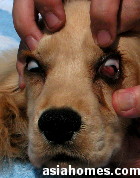 |
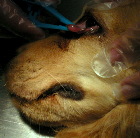 |
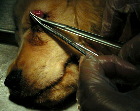 |
|
Cherry eye in the left eye of a Cocker Spaniel puppy |
Under anaesthesia, the nictitans gland is grasped by
forceps. |
Forceps clamp at its base to reduce bleeding. As
little of the gland as possible is cut off as it is
involved in tear production.
|
 |
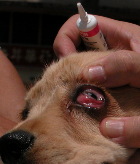 |
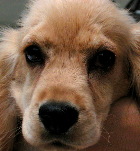 |
|
The gland is around 1 cm in diameter and a
soft mass of tissue. Curved scissors for eye surgery are best for this
surgery. |
Day 2 after surgery.
Antibiotic eye ointment
is applied twice per day for 3 days.
|
Cherry eye
excised |
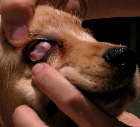 The
normal nictitans gland in the 3rd eyelid of the right eye is a small
swelling and hidden under the 3rd eyelid. It can be seen only when you
press the upper eyeball down. The
normal nictitans gland in the 3rd eyelid of the right eye is a small
swelling and hidden under the 3rd eyelid. It can be seen only when you
press the upper eyeball down.
|
|
 TOA
PAYOH VETS
TOA
PAYOH VETS TOA
PAYOH VETS
TOA
PAYOH VETS